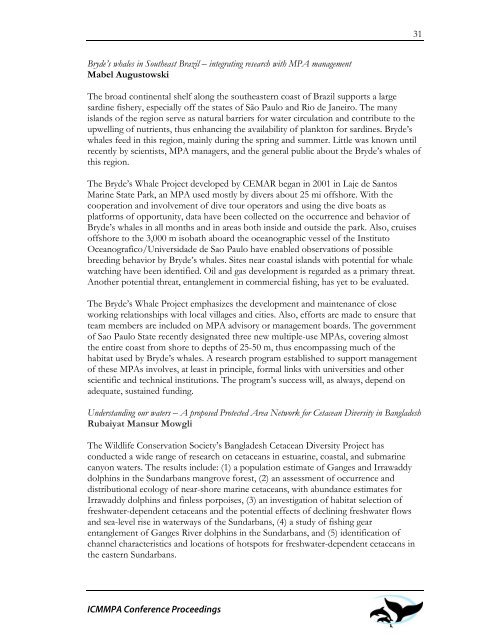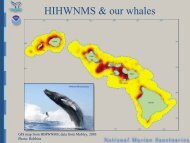The First International Conference on Marine Mammal Protected Areas
The First International Conference on Marine Mammal Protected Areas
The First International Conference on Marine Mammal Protected Areas
Create successful ePaper yourself
Turn your PDF publications into a flip-book with our unique Google optimized e-Paper software.
Bryde’s whales in Southeast Brazil – integrating research with MPA management<br />
Mabel Augustowski<br />
<str<strong>on</strong>g>The</str<strong>on</strong>g> broad c<strong>on</strong>tinental shelf al<strong>on</strong>g the southeastern coast of Brazil supports a large<br />
sardine fishery, especially off the states of São Paulo and Rio de Janeiro. <str<strong>on</strong>g>The</str<strong>on</strong>g> many<br />
islands of the regi<strong>on</strong> serve as natural barriers for water circulati<strong>on</strong> and c<strong>on</strong>tribute to the<br />
upwelling of nutrients, thus enhancing the availability of plankt<strong>on</strong> for sardines. Bryde’s<br />
whales feed in this regi<strong>on</strong>, mainly during the spring and summer. Little was known until<br />
recently by scientists, MPA managers, and the general public about the Bryde’s whales of<br />
this regi<strong>on</strong>.<br />
<str<strong>on</strong>g>The</str<strong>on</strong>g> Bryde’s Whale Project developed by CEMAR began in 2001 in Laje de Santos<br />
<strong>Marine</strong> State Park, an MPA used mostly by divers about 25 mi offshore. With the<br />
cooperati<strong>on</strong> and involvement of dive tour operators and using the dive boats as<br />
platforms of opportunity, data have been collected <strong>on</strong> the occurrence and behavior of<br />
Bryde’s whales in all m<strong>on</strong>ths and in areas both inside and outside the park. Also, cruises<br />
offshore to the 3,000 m isobath aboard the oceanographic vessel of the Instituto<br />
Oceanografico/Universidade de Sao Paulo have enabled observati<strong>on</strong>s of possible<br />
breeding behavior by Bryde’s whales. Sites near coastal islands with potential for whale<br />
watching have been identified. Oil and gas development is regarded as a primary threat.<br />
Another potential threat, entanglement in commercial fishing, has yet to be evaluated.<br />
<str<strong>on</strong>g>The</str<strong>on</strong>g> Bryde’s Whale Project emphasizes the development and maintenance of close<br />
working relati<strong>on</strong>ships with local villages and cities. Also, efforts are made to ensure that<br />
team members are included <strong>on</strong> MPA advisory or management boards. <str<strong>on</strong>g>The</str<strong>on</strong>g> government<br />
of Sao Paulo State recently designated three new multiple-use MPAs, covering almost<br />
the entire coast from shore to depths of 25-50 m, thus encompassing much of the<br />
habitat used by Bryde’s whales. A research program established to support management<br />
of these MPAs involves, at least in principle, formal links with universities and other<br />
scientific and technical instituti<strong>on</strong>s. <str<strong>on</strong>g>The</str<strong>on</strong>g> program’s success will, as always, depend <strong>on</strong><br />
adequate, sustained funding.<br />
Understanding our waters – A proposed <strong>Protected</strong> Area Network for Cetacean Diversity in Bangladesh<br />
Rubaiyat Mansur Mowgli<br />
<str<strong>on</strong>g>The</str<strong>on</strong>g> Wildlife C<strong>on</strong>servati<strong>on</strong> Society’s Bangladesh Cetacean Diversity Project has<br />
c<strong>on</strong>ducted a wide range of research <strong>on</strong> cetaceans in estuarine, coastal, and submarine<br />
cany<strong>on</strong> waters. <str<strong>on</strong>g>The</str<strong>on</strong>g> results include: (1) a populati<strong>on</strong> estimate of Ganges and Irrawaddy<br />
dolphins in the Sundarbans mangrove forest, (2) an assessment of occurrence and<br />
distributi<strong>on</strong>al ecology of near-shore marine cetaceans, with abundance estimates for<br />
Irrawaddy dolphins and finless porpoises, (3) an investigati<strong>on</strong> of habitat selecti<strong>on</strong> of<br />
freshwater-dependent cetaceans and the potential effects of declining freshwater flows<br />
and sea-level rise in waterways of the Sundarbans, (4) a study of fishing gear<br />
entanglement of Ganges River dolphins in the Sundarbans, and (5) identificati<strong>on</strong> of<br />
channel characteristics and locati<strong>on</strong>s of hotspots for freshwater-dependent cetaceans in<br />
the eastern Sundarbans.<br />
ICMMPA <str<strong>on</strong>g>C<strong>on</strong>ference</str<strong>on</strong>g> Proceedings<br />
31



